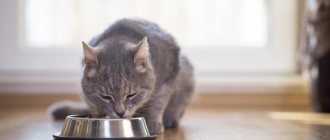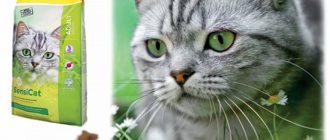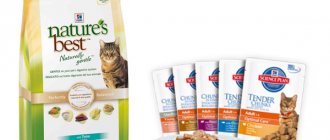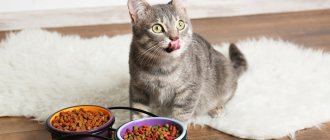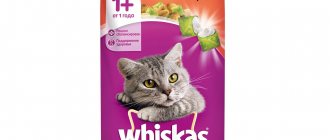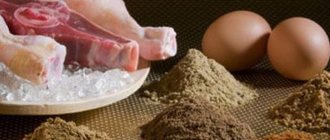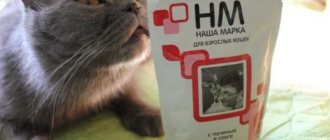The health of pets largely depends on their diet. Today, most of them eat industrial powdered formula. And in order to choose the right food for your cat, you need to be able to decipher its composition. Let’s say right away that you shouldn’t buy economy class food, they contain a lot of ingredients and flavorings that are harmful to animals, it is better to give preference to premium and super premium classes.
How dry industrial mixtures are produced
Before a brand is approved for release, feline nutritionists work. They develop and approve the composition of the final product.
According to the finished recipe, all components are mixed in special units: meat, offal, vegetable raw materials, additional ingredients - preservatives, stabilizers, additives. The finished mass is pressed through a sieve, the cells of which have the shape of future granules.
After drying, the finished pieces are treated with a special composition - a mixture of fat and ingredients that give the food a taste that is attractive to the cat.
Meat after drying cannot occupy more than half the volume, its usual rate is lower - about 35 percent, therefore, if it is not in first place in the list on the product label, this is normal.
The advantage of any food is the absence of flavors and dyes, components that are clearly harmful to animals.
The daily intake of the mixture is also important - the lower it is, the more nutritious the food.
The moisture content of dry food is always no more than six percent.
What shouldn't be in cat food
In a good food, the proportion of grains should be kept to a minimum, up to the complete absence of grains in the composition. This component is practically not absorbed by cats. Its main task is to provide the animal’s body with carbohydrates and fiber. Vegetables and fruits, which have greater nutritional value, cope better with this. Cereals are often used as a cheap filler. The most dangerous of them are corn and wheat. They often cause the development of allergies. The presence of barley and oats is more acceptable, however, their share should be minimal.
Sometimes manufacturers replace grains with beans or potatoes, but in reality this makes little difference: cats need meat more than plant ingredients
The presence of any common names is not welcome. This applies to both animal and plant components. The presence of vague concepts in the list of ingredients indicates either the low quality of the raw materials (i.e., the manufacturer is hiding something) or the instability of the composition. In the latter case, the manufacturing company retains the ability to use different components in each batch. This does not correspond to the biological needs of cats: in the wild, the chemical composition of game remains almost the same. Frequent menu changes contribute to digestive disorders.
Some of the most common unwanted components include the following:
- Bird. It may turn out to be either chicken or turkey. The first is, of course, more likely. The definition of “poultry” does not characterize the ingredient, since the manufacturer does not specify what exactly the food contains: meat, internal organs, skin or something else. In most cases, the name “poultry” hides cheap by-products that have no nutritional value.
- Meat. An even more vague component than “bird”. This can equally well include chicken, beef, pork and even fish. In most cases, the manufacturer uses low-quality components. If an allergy occurs, it will be difficult for the pet owner to understand what caused the problem.
- Fish. The disadvantages are the same as those of the above ingredients.
- Animal fat. Of course, it is commendable that the manufacturer does not use only vegetable oils, but the source of the component must be indicated.
- Cereals. Any variety can be hidden under this name. Most often, manufacturers try to hide the presence of corn and wheat in the composition using a common name.
- Vegetables. The ingredient is often mentioned by unscrupulous companies. This marketing ploy is designed for inexperienced buyers: many people will think that the presence of vegetables in the composition is a huge plus, because they contain useful substances. In reality, manufacturers usually do not use whole luxury products, but rather individual parts. For example, partitions. In addition, carnivores do not absorb nutrients from vegetables well, so there is no need for large amounts of plant ingredients. It is preferable to indicate specific varieties.
- Offal. A component can be either beneficial or harmful depending on the composition of the mixture. If a manufacturer doesn't specify a specific type of ingredient, they likely have something to hide.
- Processed products. In other words, industrial waste. For the sake of economy, those components that remain after the production of other products are added to the feed. In the case of ingredients of animal origin, this may be so-called pink slime. It remains after cutting the carcasses. If these are products of processing of plant components, then the manufacturer probably means peeling, peeling, etc.
The presence of vitamins, minerals and amino acids in dry food in their pure form is not recommended. Ideally, the diet should be as close as possible to the natural menu, not only in chemical composition, but also in content. Animals absorb certain supplements less well than the same beneficial substances from whole ingredients. In addition, the presence of amino acids indicates a lack of meat in the feed. In a cat's natural environment, the same taurine is obtained from animal products.
In general, there is nothing dangerous in the above ingredients, but there is also little useful in them. This becomes the reason for the development of pathologies when feeding economy and premium products. Due to a deficiency of amino acids, minerals and vitamins, systemic diseases progress slowly and asymptomatically. As a result, in most cases, organ dysfunction becomes known too late. I personally know of three similar cases: 2 cats were diagnosed with urolithiasis, one had decomposition of the pancreas. One of them was eating Royal Canin food. It’s a shame that such a popular company with expensive products is profiting from the health of pets through aggressive marketing.
Wet food
They can be considered an intermediate link between canned food and dry mixes.
The main difference is humidity and packaging. These are usually single-dose food packets that are soft morsels in a jelly or sauce. Their humidity is much higher than that of dry food, but lower than that of canned food and is no more than 35 percent.
If the cat does not finish the portion, it quickly dries out and becomes unusable. You can put half a sachet in a bowl, open it and store it in the refrigerator.
Composition of special feeds
Specialized feeds have completely different requirements, so their composition may differ from the standard one.
Kitten food
Kittens should receive more vitamins, unsaturated fatty acids, minerals and calories, as their body is actively developing. It is desirable to have colostrum or other supplements that strengthen the immune system. Fish oil provides the kitten’s body with fatty acids and vitamins E, so its presence is preferable.
Most often, the composition of kitten food is the highest quality among the entire line, so it can be used to indirectly evaluate the brand’s products as a whole.
Food for older cats
Foods for older cats are often lower in calories, because as animals get older they become less active, which can cause obesity. Diets include preventative supplements to maintain joint health.
Food for sterilized cats
Food for sterilized animals has a reduced calorie content. Due to the disappearance of the reproductive instinct in cats, sexual hunting stops, which takes a lot of energy. This increases the risk of obesity. It is desirable to have preventive additives (berries or fruits) in the composition to normalize the acidity level of urine. This prevents the development of ICD. Foods for neutered cats may contain less minerals to reduce the risk of stone formation.
Preventive and therapeutic feeds
The composition features differ depending on the type of feed. Let's look at the main types of specialized diets:
- For removing fur. The composition includes more sources of fiber (vegetables and fruits) for the timely capture and removal of hairs from the gastrointestinal tract.
- For the treatment of kidney diseases. Reduced proportion of phosphorus. Supplements (aloe, flax seeds, etc.) can be introduced to protect the mucous membranes of the gastrointestinal tract: with uremic syndrome there is a high risk of damage to them.
- For the treatment of pathologies of the lower urinary tract. Reduced proportion of minerals. Added ingredients to normalize urine acidity.
- To maintain liver health. The proportion of fats and proteins is reduced to reduce the load on the diseased organ and prevent the development of encephalopathy.
- Hypoallergenic. The food has a laconic composition. Rare meats may be present.
When choosing a hypoallergenic food, you should carefully study the composition: often unscrupulous manufacturers do not add meat to the diet at all
- Diabetic. Wheat and corn are replaced with sources of slow carbohydrates - barley, oats and beans.
- For the treatment of gastrointestinal diseases. If your cat is constipated, you should give her food with a high concentration of fiber. In case of hypersensitivity, gastritis, colitis and other pathologies, the proportion of coarse fibers is reduced and pro- and prebiotics are added.
- To improve the condition of coat and skin. The composition includes fish and fish oil: they contain unsaturated acids and vitamin E, which promote hydration and shine.
Canned food - production and difference from dry food
Wet food is produced similarly to dry food, but instead of drying, the technology includes preservation of the semi-finished product.
The moisture content of canned cat foods - purees, stews, jelly, mousses and others - reaches eighty percent. It is important to know it in order to correctly determine the composition of other components, most importantly - proteins and fats.
For example, at 80% humidity, the can says 5% fiber content. By calculating this share from the remaining 20% of dry products, you can see that in fact its content is 25%. The same recalculation can determine the content of fats, proteins, and macroelements.
It’s a bad sign if the canned food label contains the words “flavors of.” This only means that the composition contains artificial flavors.
In developed countries, it is prohibited to write “all” on the label, which means that the product consists of 100% one component - meat, fish, etc. This is technologically impossible and is a trick of the manufacturer, a deception.
Vitamins, minerals and other additives in dry food
We all know that good food means balanced. But there is no need to check this balance: any complete product for cats, regardless of its quality, contains the necessary macro- and micronutrients within the normal range. As a rule, this is achieved through the use of vitamin and mineral supplements, although in nature the animal receives the same substances naturally - from food.
Having caught a bird, the cat eats it completely, with giblets, skeleton and feathers, thereby receiving all the necessary micronutrients in an easily digestible form. This fact was taken into account when creating Akana and Orijen products. These cat foods contain not only muscle meat, but also animal entrails, cartilage and small bones in natural proportions. This approach enriches the predator’s diet and minimizes the need to use any kind of additives.
Raw natural food
A fairly young generation of super premium food. These are natural meat products, usually blast frozen. Every year they become more and more popular among supporters of healthy animal nutrition, since this diet is most similar to the natural one. In our country you can buy such food from American brands Balanced Blends, Darwin's Natural Pet Products, Primal. A well-known domestic brand is Superpet.
Natural food contains fresh raw meat (chicken, turkey, quail, beef, lamb, rabbit), vegetables, eggs (quail and chicken), bran, vitamins and microelements.
The advantages of such nutrition are the absence of vegetable protein, preservatives, flavors and flavor enhancers.
Cat food composition: grains and beans
Pea Protein is a low quality protein source.
Pea Flour – Made from roasted peas, this improves the digestibility of pea protein.
Corn Gluten Meal – corn protein (poorly digestible).
Corn starch is a source of carbohydrates, a filler that helps form feed granules.
Corn Meal is a source of protein and carbohydrates, a filler that helps form feed granules.
Oatmeal (Oat Flour, Oatmeal) is a source of easily digestible carbohydrates and vegetable proteins. A filler that helps form feed pellets.
Wheat Gluten – wheat protein (poorly digestible).
Wheat Flour is a filler that helps form feed granules.
Rice Flour – flour made from polished (white) rice. Source of carbohydrates. Filler for forming feed granules.
Brown rice, brown (Brown Rice) - unpolished rice. Source of carbohydrates, protein, vitamins and minerals. In large quantities, it can cause taurine to be eliminated from the cat’s body too quickly.
Brewers Rice is a by-product of rice production. A source of dietary fiber, a filler that helps form feed pellets. In large quantities, it can help remove taurine from the cat’s body.
Tapioca, tapioca starch, tapioca flour (Dried Tapioca, Tapioca Starch, Tapioca Flour) – cassava starch. A source of carbohydrates, a filler that helps form feed pellets. Not the best alternative to grain because... contains very little protein and a lot of sugar.
Barley Grass is a source of dietary fiber.
Industrial feed composition tables
The tables list all possible components and evaluate them; those that may be harmful to the cat’s health are separately noted.
Meat ingredients
| Ingredient | Allowed and prohibited components | |
| Meat* | Beef pulp, fat, cartilage, heart, tongue, etc. | |
| Meat by-products | Entrails, bones and blood. There should be no horns, teeth, hooves, fur. | |
| Bird | Carcasses with bones and skin. | |
| Poultry by-products | Bird entrails, bones and blood. No - feathers. | |
| Flour | meat | Dried and ground meat and offal. Cannot contain bones, blood, fur, feathers, hooves, horns, etc. |
| meat and bone | Dried and ground meat, bones and offal. Phosphorus content – not less than 4%, calcium – 8.8%. The protein content (digested with pepsin) is no more than 12%. | |
| from offal | Dried and ground meat and offal into flour. | |
| Hydrolyzed protein | Protein broken down into amino acids. According to manufacturers, it does not cause allergies in cats. The nutritional value and safety for the animal are questionable. | |
| Bacon | Natural flavor. | |
| Bouillon | A decoction of meat and bones (the label should indicate what it is from - pork, fish, etc.). Typically includes monosodium glutamate. A good alternative to water to increase feed moisture. | |
| Fat | beef | Natural attractant, source of Omega-6 acids. |
| chicken | ||
| Chicken oil – rendered internal fat | ||
| Skim milk | Typically used only in kitten foods. Contains protein and lactose, which are not digestible by adult cats. | |
| Porcine plasma | Low quality protein from: | blood. |
| Egg powder | crushed and dried eggs. | |
*Meat - beef, pork, goats, sheep - do not require the type of animal to be indicated on the label. Poultry, venison, buffalo and others - species must be specified.
Cereal ingredients
| Fillers forming feed granules | ||
| Ingredient | Is the source, properties | |
| Corn starch | Carbohydrates | |
| Flour | corn | Carbohydrates and plant proteins. |
| oatmeal | ||
| wheat | ||
| rice made from polished white rice | ||
| Wheat gluten | ||
| Beer rice | In high quantities it destroys taurine. | |
| Tapioca | In the form of starch and flour. Low protein, high carbohydrates. | |
| Other components | ||
| Pea protein | Low quality vegetable protein. | |
| Corn gluten | ||
| Pea flour | Crushed fried peas improve the digestibility of pea flour. | |
| Dark rice | Carbohydrates, proteins, vitamins, minerals. In high quantities it destroys taurine. | |
| Barley | Source of dietary fiber. | |
Vegetables and fruits, greens
| Fillers forming feed granules | ||
| Ingredient | Is the source, properties | |
| Sweet potato | Carbohydrates and dietary fiber. | |
| Blackberry | Dietary fiber. | |
| Potato starch | Carbohydrates. | |
| Other Ingredients | ||
| Carrot | Dietary fiber. | |
| Plantain | ||
| Pumpkin | ||
| Zucchini | ||
| Blueberry | Vitamins and antioxidants, acidifier. | |
| Cranberry | Vitamins, acidifier. | |
| Rosemary | Natural preservative. | |
| Blueberry extract | ||
| Garlic | ||
| Alfalfa | Green sprouts, low quality vegetable protein. | |
| Molasses | Sugarcane waste, calcium and betaine. | |
| Ginger | Normalization of digestion | Removing hairballs. |
| Parsley | Breath freshening. | |
| Thyme | In minimal quantities, toxic, antiparasitic agents. | |
| Garlic | ||
| Yucca | Eliminates and masks unpleasant odors of granules and feces. | |
Lactobacilli
| Lactobacillus acidophilus | Probiotics are substances that contain live bacteria from the body’s own microflora. |
| Bacillus subtilis | |
| Bifidobacterium Thermophilum | |
| Enterococcus Faecium | |
| Bifidobacterium Longum |
Yeast, fiber
| Fillers forming feed granules | |
| Ingredient | Is the source, properties |
| Tomato paste | Dietary fiber. |
| Cellulose | |
| Perilla | A mint type plant. Source of Omega-3 and Omega-6 fatty acids. In concentrated form it causes diarrhea. Considered toxic. Used only in feed produced in China, Korea and Japan. |
| Other components | |
| Chicory root extract | Inulin, prebiotic*. |
| MOS, FOS | |
| Peas and pod | Dietary fiber. |
| Oat bran | |
| Beet pulp and pulp | |
| Flax-seed | |
| Seeds, skin and pulp of tomatoes | Prebiotic. |
| Brewer's yeast | Low-quality vegetable protein, prebiotic*. |
| Rice bran | Dietary fiber in large quantities is destroyed by taurine. |
*Prebiotic is a growth stimulator of living bacteria of the body’s own microflora.
Vitamins and minerals
| Ingredient | Is the source, properties | |
| Iron proteinate | Gland. | |
| Amino acid chelate | cobalt | Amino acids and vitamin B12. |
| magnesium | Amino acids and magnesium. | |
| copper | Copper. | |
| zinc | Zinc. | |
| Yodat | potassium | Iodine and potassium. |
| calcium | Calcium. In minimal quantities it can cause thyroid dysfunction. | |
| Carbonate | calcium | Calcium. Prevents granules from sticking together. |
| cobalt | Vitamin B12. | |
| Sulfate | calcium | These elements. |
| gland | ||
| magnesium | ||
| manganese | ||
| copper | ||
| zinc | ||
| chondroitin | Prevents joint disease. | |
| Phosphate | dicalcium | Phosphorus and calcium. |
| calcium | ||
| tricalcium | + prevents granules from sticking together | |
| Sodium Selenite | Sodium. | |
| Zinc oxide | Zinc. | |
| Betaine anhydrous | Choline substitute. | |
| Sodium bisulfate | Vitamin K, acidifier. | |
| Thiamine mononitrate | B1. | |
| Pantothenate | calcium | B5, pantothenic acid. |
| calcium D | Synthetic pantothenic acid. | |
| Tocopherol | Natural preservative, vitamin E. | |
Dyes, preservatives, attractants
| Ingredient | Properties, characteristics | |
| Flavors | artificial | Synthetic additives with odors. |
| natural | Obtained from natural raw materials, such as fat. | |
| Ascorbic acid | Natural preservative. | |
| Gelatin | Low quality protein, collagen. | |
| Gum | Natural gelling and stabilizing agent. | |
| Caramel | Natural dye. | |
| Sodium | nitrite | Color stabilizer, carcinogen. |
| chloride | Natural preservative, stimulator of water consumption in animals. | |
| Red 3 | Dye, carcinogen. | |
| Ethylenediamine | Iodine. | |
*Attractant is a component that affects a cat’s taste buds, attracting it.
Protein
Chicken Uses meat, skin and sometimes bones. Heads, paws, entrails and feathers are not used. The most “gentle” product. Dogs that do not digest meat ingredients well often digest chicken ingredients very well.
Chicken meal Obtained from chicken meat and skin. Chicken meal is perhaps the best protein product used in commercial feeds. Tasty, easily digestible and very expensive.
Chicken by-product meal Consists of ground up body parts of a slaughtered chicken such as neck, legs, undeveloped eggs and innards.
Turkey Uses meat, skin and sometimes bones. Heads, paws, entrails and feathers are not used. In no way inferior to chicken.
Turkey meal A very nutritious, easily digestible and appetizing product.
Duck Uses muscle tissue, skin and sometimes bones. Heads, paws, entrails and feathers are not used. An excellent source of proteins, which also contains amino acids important for the skin of dogs.
Salmon An excellent source of protein and Omega 3 fatty acids.
Salmon meal An excellent source of protein and Omega 3 fatty acids.
White fish Deep-sea fish of the whitefish family. An excellent product, rich in protein and Omega fatty acids.
Fish Cleaned fish and trimmings are used. An excellent component rich in proteins. It has a strong effect on the coat due to the content of phosphorus and other elements.
Ocean fish An excellent resource of fatty acids and proteins.
Fishmeal The dried, ground tissue of half-broken whole fish or pieces of fish, either or both, with or without the extraction of some of the oil. A nutritious product slightly inferior to whole fish. The specific varieties of fish are unknown.
Chicken eggs are rich in protein and amino acids.
Dry egg powder Egg powder is produced from egg processing waste (shells, undeveloped eggs, etc.). Their value is much lower than a whole egg.
Chicken liver is potentially dangerous. Primarily used to improve the palatability of feed. Like any liver, it can contain toxins.
Poultry liver is potentially dangerous because... Without identifying a specific animal in the name, it is impossible to say which liver (goose, duck, chicken) was used in the production of feed. In addition, the liver of animals often retains remnants of toxins.
Poultry by-product meal is potentially dangerous. Includes liver, kidneys, brains, etc. Almost any part of the animal carcass, except meat, can be part of this ingredient. Much less nutritious than meat. The specific composition is unknown.
Soy protein concentrate is potentially allergenic! Protein concentrate is obtained from dehydrated and defatted soybeans. Used to reduce the cost of feed. Often the raw material used to obtain the concentrate is a genetically modified product. In addition, soybeans often cause allergies in some animals.
Animal mixture - potentially allergic. Dry material obtained by chemical and/or enzymatic hydrolysis of clean and undisintegrated tissue. Animal tissues used must be free from hair, teeth, hooves and feathers, except in the minimum amount that is inevitably present even with good production processes and is suitable for animal feeding.
Composition analysis by class
The most expensive and high-quality food is super premium food, followed by premium and economy.
The cheapest foods are the most widely advertised and are still in great demand. But you cannot feed a cat such mixtures for a long time.
Premium and super premium food are much more expensive, as they are made from high-quality raw materials and differ only in the percentage of meat ingredients.
Super premium and holistic are the best options as they serve as a complete replacement for raw meat. The high price corresponds to their quality. Even if you switch your cat to natural food, you will have to additionally introduce vitamin supplements, micro- and macroelements into the diet; this option is unlikely to be cheaper.
Features of food selection
There are many quality criteria, but the main ones can be identified.
Table: feed analysis depending on class
| Class | What's included | Advantages | Flaws | Popular representatives |
| Economy |
| Relatively low price: 1 kg of feed costs approximately 100 rubles. |
|
|
| Premium |
|
| In general, premium food is almost no different from budget products: the share of meat components in them is also small, but there are many common names and herbal ingredients. Digestibility is slightly higher, but the animal still does not receive enough substances, which leads to deterioration in health. |
|
| Super premium |
|
| The key disadvantage is the high cost, but many popular premium foods cost the same: about 500–700 rubles. for 1 kg |
|
| Holistic |
| Holistic-grade food meets the biological needs of cats and allows you to get all the necessary nutrients | High price |
|
Ingredient positions
The first thing you need to pay attention to is the position of the components in the composition. At the beginning there must certainly be meat or whole carcasses. Cereals, vegetables or by-products should not occupy a leading position. Since we are talking about cat food, the basis of the diet should be meat.
Orijen dry food is a prime example of high-quality ready-made diets: the first 5–10 positions in the list of ingredients are consistently occupied by products of animal origin
Ideally, there should be several meat components in the first place. The presence of grains in the feed is permissible only if they are located at the end of the list. The presence of several varieties of grains or their components (gluten, extract, flour, etc.) close to the beginning of the composition indicates a predominance of plant proteins over animal proteins, which is unacceptable for cats. Many manufacturers are trying to mislead buyers in this way: they indicate wheat, corn, wheat gluten, and flour in the list of ingredients, but in the first place they leave fresh meat, which is taken into account along with water. As a result, the share of easily digestible animal products is less than 10%.
It is desirable to have a percentage of the main components in the composition. This allows you to get at least a rough idea of the quality of the feed. Typically, the percentage of components is indicated by manufacturers of holistic and super-premium diets. Companies involved in the production of budget food hide information.
Ash content
During the preparation of dry food, heat treatment destroys some organic components. Inorganic substances, which are minerals, do not burn. It is this remaining part that is commonly called ash. This is not a harmful additive, a cheap filler or a by-product, but substances that the cat’s body needs to function properly. It was previously believed that ash increased the risk of developing urolithiasis, but in the 1980s scientists proved that this was not the case.
Most grain-free foods have a high ash content (8–9%), so cats eat them less readily.
The level of ash content depends on the raw materials used. For example, when pulp is processed, less inorganic substances will remain than when bones or muscles are burned. For this reason, high ash content in cheap feeds may indicate the use of low-quality ingredients. A low concentration of minerals is also dangerous, since the animal does not receive enough useful substances from such food. Additionally, ash content affects the palatability of the food: if there is too much inorganic residue, the pet will refuse food. For example, my cat turns away from many foods that contain more than 8% ash.
The optimal figure is considered to be 6–7%. In fact, many holistic foods contain 9-10.5% ash. This is due to the use of preventative supplements and herbal raw materials instead of minerals. For castrated cats, it is advisable to purchase food with low ash content in order to normalize the acidity of urine, but it is better to focus on the concentration of magnesium, calcium and phosphorus.
Digestibility
The digestibility of feed should be maximum: the more nutrients the pet receives from the diet, the better. The optimal level is considered to be 25%. Digestibility can be indirectly determined by the volume of animal feces. The less the cat’s body receives substances from food, the more feces are excreted, i.e. the ingredients simply pass through the gastrointestinal tract in transit.
By-products
By-products themselves are an ambiguous component. On the one hand, they may contain useful substances. On the other hand, manufacturers of budget food often use cheap by-products as a filler.
Lamb lung contains a lot of cartilage tissue, so it helps prevent the development of pathologies of the musculoskeletal system
High-quality diets include liver, lungs, kidneys, and sometimes hearts, cartilage and chicken heads. Such by-products provide the animal’s body with glucosamine, chondroitin, amino acids, energy, minerals, vitamins, etc. This is only true if the total share of such ingredients does not exceed 15%. If the manufacturer uses high-quality components, he indicates their type and does not hide the composition of the mixture.
Cheap offal can actually be anything. For example, a cancerous tumor, a bladder with its contents, intestines, horns, bones, beaks, etc. Such additives have zero nutritional value and can even pose a danger to animals. If a manufacturer uses low-quality by-products, he usually indicates common names: “by-products”, “processed products”, etc.
Table of comparative analysis of feed by class
Characteristics of industrial cat food are given in the table.
| Characteristic | Trademark | % meat content | Price 1 kg, rub. |
| Economy | |||
| They contain by-products from meat ingredients, and low-quality grains and soy from vegetable ingredients. Additives include many carcinogens and artificial flavors. The cheapest and most undesirable class of food for a cat’s diet. Lead to indigestion, allergies, and chronic diseases. Sold in all supermarkets and widely advertised. | Whiskas, Friskas, Kitekat, Darling, Felix, Cat Chow (Cat Chow), Purina Van (Purina One), Perfect Fit (often classified as premium, but it does not reach it) | From 4 to 6 | From 80 |
| Premium | |||
| Average quality ingredients used. Quite a high content of animal proteins. Well absorbed by the cat's body with the least amount of indigestible waste. The cost is 20-50 percent higher than economy class. Most often sold in pet stores. | 1st Choice, Happy Cat, Hills, Proplan, Royal Canin, Yams, Probalance | From 10 to 20 | From 250 |
| Super premium | |||
| They have a balanced composition, high nutritional value, and are completely absorbed by the cat’s body. Contains natural meat and high-quality cereals. They do not contain artificial additives, taste improvers or carcinogenic substances. Expensive. Sold only in pet stores. | Monge, Leonardo, Bozita, Nature's Protection | 50 or more | From 700 |
| Holistics | |||
| Protein - only fresh and dehydrated meat and fish. No plant materials. Carbohydrates - potatoes, rice, peas, lentils. No corn, wheat. Only natural preservatives (tocopherols). Fiber - vegetables, fruits, dried berries. Hypoallergenic product. Sold only in specialized pet stores. | Akana, Orijen, Go Natural! (Go Natural), Now, Golden Eagle Holistic Health (Golden Eagle Holistic), Pronature Holistic | 50 and above | From 1450 |
What does a cat need?
Cats are obligate carnivores, meaning their diet consists primarily of meat. Pets need animal proteins and amino acids more than carbohydrates. They need connections not only to obtain energy, but also to ensure the correct functioning of all organs and systems.
In their natural environment, animals hunt small game: rodents, birds, etc. From the stomachs of the victims, cats obtain a small amount of cereals, vegetables and fruits. Products in the gastrointestinal tract of birds and rodents are subject to primary processing with enzymes. In this form, they are relatively well absorbed by the cat’s body, but most of the beneficial substances still leave the intestines unchanged. The resulting plant food helps satisfy the daily need for those microelements that are not found in meat.
When eating natural products, 75–80% of the menu is meat, 10–15% is allocated to offal and 10% is reserved for fermented milk products and vegetables
Like all living beings, a cat needs water, so it is advisable to give it not only dry, but also wet food. The granulated product contains practically no liquid, which can become an additional risk factor if the drinking regime is not followed. Dehydration can lead to problems with the gastrointestinal tract, kidneys, cardiovascular system and other organs. In some cases, wet food is the only acceptable option. For example, my cat has very sensitive digestion: after eating granules, she has blood in her stool. After the examination, the veterinarian said that this is an individual feature, in general the animal is healthy, but it is better to switch to pouches and pates. Hard granules damage the delicate internal lining, which can later cause inflammation and infection. The cat does not have such a reaction to wet food.
Specialized feed
Each brand has a line of specialized food. Veterinarians recommend choosing such products for pets, as they include many factors that affect the activity and health of cats.
The main feeds by type and purpose are intended for:
- Kittens - used exclusively for feeding young animals, from super premium class producers they are often divided into age groups - from one to three months; from three to six and so on.
- Sterilized kittens - for young animals who have undergone early castration. This diet is suitable for up to 12 months.
- Kittens and lactating cats. Some luxury food manufacturers produce a special product that is suitable for kittens, pregnant and lactating cats.
- Young animals (from 1 year to 7 years) - this is the usual diet of a young, mature cat or cat without developmental disabilities or chronic diseases.
- Elderly - cats over seven years of age need a special diet with easily digestible proteins and fewer carbohydrates. Many manufacturers have 7+ and 12+ lines.
- Spayed and neutered. Neutered men often develop various diseases associated with less activity. This line is intended to prevent them. Inside it, food is divided according to the age of the animal.
- So-called gastrofeeds are intended for animals with diseases of the gastrointestinal tract.
- Cats with urolithiasis - the composition of these mixtures is balanced in such a way as to prevent the disease from progressing.
- Pets with sensitive digestive systems. They, in turn, are divided into age groups.
- Long-haired - contain a high content of ingredients responsible for removing hairballs from the gastrointestinal tract.
- Active, often outdoors - contain a high content of proteins, fats and carbohydrates, as well as anti-parasitic additives.
- Those who are picky about the taste of the product, as well as a line for those who are capricious in aroma or composition.
- Prone to overeating and obesity.
- For the prevention of dental plaque.
- Preventing the formation of hairballs in the gastrointestinal tract.
- Adult cats to maintain healthy skin and coat.
- And also hypoallergenic food.
This is not a complete list of the types of specialized diets produced by major brands.
In addition, many manufacturers produce food intended for specific breeds. For example, Royal Canin has a line of the following types of dry mixes for:
- Maine Coons (kittens, adults);
- Siberian cats;
- Siamese;
- Norwegian forest;
- Bengals;
- sphinxes;
- British Shorthair (kittens, adults);
- Persians (kittens, adults).
Composition of cat food: vegetables, fruits, greens
Sweet potatoes, sweet potatoes (Sweet Potatoes) are a source of carbohydrates and dietary fiber, a filler for the formation of feed granules.
Blackberries (Blueberries) are a source of dietary fiber.
Ginger – normalizes digestion, removes hair.
Potato starch (Potato Starch) is a source of easily digestible carbohydrates, a filler that helps form feed granules.
Cranberries are a source of vitamins and a urine acidifier.
Alfalfa sprouts (Alfalfa, Alfalfa Sprouts) – the green part of alfalfa. Can be used in feed as a source of low-quality protein.
Molasses is molasses, a by-product of sugar cane. Source of calcium and betaine.
Carrots are a source of dietary fiber.
Parsley (Parsley) – freshens breath and relieves stomach irritation.
Plantain (Psyllium) is a source of dietary fiber (prebiotics).
Rosemary, rosemary extract (Rosemary, Rosemary Extract) – a natural preservative.
Thyme is an antiparasitic agent, toxic in large quantities.
Pumpkin, squash, butternut squash (Pumpkin, Squash) are a source of dietary fiber.
Blueberries are a source of vitamins and antioxidants. It is also used to acidify urine in cats.
Blueberry extract (Blackberries Extract) – a natural preservative.
Garlic (Garlic) is an antiparasitic agent, toxic in large quantities, a natural preservative.
Zucchini is a source of fiber.
Yucca Schidigera Extract – eliminates the unpleasant odor of cat feces; may mask poor quality feed composition.
Fat levels in cat foods
Unlike people, cats and dogs never suffer from atherosclerosis, because such a thing as high cholesterol simply does not exist for them. Fat for these animals is the main source of energy, just as carbohydrates are for us, so the average fat content in dry food is 14–15%. This is not much, there are also fattier foods, but this is not a big deal if the food contains few carbohydrates (their sources are usually grains), but when their level reaches 50%, the cat will receive too many extra calories, which, given low energy consumption, will turn out to be unnecessary weight and obesity.
So you shouldn’t be afraid of fat in the food, but it is very important that it be animal and not vegetable. The latter is poorly digestible and does not contain essential omega-3 fatty acids for cats. Its best sources are fats from meat (chicken, lamb, etc.), as well as fish oil, which holds the record for omega-3 content.
Should food contain preservatives and flavorings?
Without a doubt, there must be preservatives, otherwise long-term storage of the feed will not be achieved. But the question is, which ones? The development of the modern food industry makes it possible to use natural antioxidants for this purpose - substances that prevent the oxidation of fats, the main cause of food spoilage.
They are extracted from plants, most often rosemary, and they help maintain the freshness of the product without having a negative impact on the health of the animal. But synthesized chemical compounds that have the same effect can have unpleasant side effects.
The same applies to flavors with dyes. The latter are not necessary at all, since the color of the granules does not matter for animals, but it is quite possible to make dry food more attractive in smell without resorting to artificial additives. It is enough to include more high-quality meat ingredients, and your pet will not be torn away from the bowl.
By the way, for the same purpose, manufacturers add hydrolyzed or dehydrated liver - even in small quantities it gives the food an aroma that is attractive to animals.
